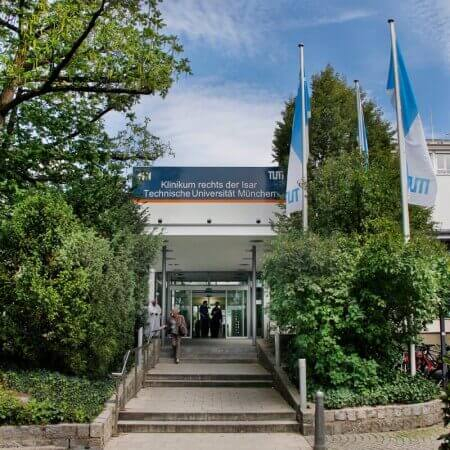Top Hospitals for Chemoembolization (TACE)
Each hospital in this list meets Booking Health’s strict international standards: at least 250 surgeries per year, ISO‑certified quality management, and documented survival outcomes. Our medical board then ranks the clinics by clinical expertise, technology, and patient‑satisfaction scores.

According to the reputable Focus magazine, the University Hospital Frankfurt am Main ranks among the top German medical facilities! The hospital was founded in 1914 and today is a well-known German medical facility, which combines rich traditions and scientific innovations. A medical team of more than 6,500 employees cares about







Treatment of liver cancer with percutaneous embolization (coiling) or chemoembolization
Price from:
9049.53
Go to the program Treatment of adrenal cancer with embolization or chemoembolization
Price from:
27818.7
Go to the program Treatment of bladder cancer with embolization or chemoembolization
Price from:
27815.57
Go to the program Treatment of bladder cancer with embolization or chemoembolization
Price from:
27531.6
Go to the program Treatment of breast cancer with embolization or chemoembolization
Price from:
28130.86
Go to the program Treatment of cervical cancer with embolization or chemoembolization
Price from:
27802
Go to the program Treatment of cholangiocarcinoma (Klatskin tumor) with embolization or chemoembolization
Price from:
27741.44
Go to the program Treatment of colon cancer with embolization or chemoembolization
Price from:
27874.03
Go to the program Treatment of kidney cancer (renal cell cancer) with embolization or chemoembolization
Price from:
27812.44
Go to the program Treatment of laryngeal cancer with embolization or chemoembolization
Price from:
27788.42
Go to the program Treatment of liver cancer with embolization or chemoembolization
Price from:
27668.36
Go to the program Treatment of liver metastases with percutaneous embolization (coiling) or chemoembolization
Price from:
9246.85
Go to the program Treatment of lung cancer with embolization or chemoembolization
Price from:
28052.56
Go to the program Treatment of neuroendocrine tumor (NET) of the colon with embolization or chemoembolization
Price from:
27623.47
Go to the program Treatment of neuroendocrine tumor (NET) of the lung with embolization or chemoembolization
Price from:
27907.44
Go to the program Treatment of neuroendocrine tumor (NET) of the pancreas with embolization or chemoembolization
Price from:
27640.18
Go to the program Treatment of neuroendocrine tumor (NET) of the stomach with embolization or chemoembolization
Price from:
28037.94
Go to the program Treatment of ovarian cancer with embolization or chemoembolization
Price from:
28107.89
Go to the program Treatment of pancreatic cancer with embolization or chemoembolization
Price from:
28125.64
Go to the program Treatment of rectal cancer with embolization or chemoembolization
Price from:
27531.6
Go to the program Treatment of stomach cancer with embolization or chemoembolization
Price from:
27940.85
Go to the program Treatment of thyroid cancer with embolization or chemoembolization
Price from:
27881.34
Go to the program 
The University Hospital Rechts der Isar Munich was founded in 1834. It combines long traditions with the very latest advances in modern medicine. The medical facility includes 33 specialized departments and 20 interdisciplinary centers, where patients can receive top-class medical care in all medical fields. The hospital annuall



Treatment of liver cancer with percutaneous embolization (coiling) or chemoembolization
Price from:
10234.47
Go to the program Treatment of bladder cancer with embolization or chemoembolization
Price from:
31464.35
Go to the program Treatment of bladder cancer with embolization or chemoembolization
Price from:
30938.17
Go to the program Treatment of breast cancer with embolization or chemoembolization
Price from:
31238.84
Go to the program Treatment of cervical cancer with embolization or chemoembolization
Price from:
31255.55
Go to the program Treatment of cholangiocarcinoma (Klatskin tumor) with embolization or chemoembolization
Price from:
31033.18
Go to the program Treatment of colon cancer with embolization or chemoembolization
Price from:
31410.06
Go to the program Treatment of kidney cancer (renal cell cancer) with embolization or chemoembolization
Price from:
31288.96
Go to the program Treatment of laryngeal cancer with embolization or chemoembolization
Price from:
31404.84
Go to the program Treatment of liver cancer with embolization or chemoembolization
Price from:
31229.45
Go to the program Treatment of liver metastases with percutaneous embolization (coiling) or chemoembolization
Price from:
10266.84
Go to the program Treatment of lung cancer with embolization or chemoembolization
Price from:
31472.7
Go to the program Treatment of neuroendocrine tumor (NET) of the colon with embolization or chemoembolization
Price from:
31053.01
Go to the program Treatment of neuroendocrine tumor (NET) of the lung with embolization or chemoembolization
Price from:
31084.33
Go to the program Treatment of neuroendocrine tumor (NET) of the pancreas with embolization or chemoembolization
Price from:
31281.65
Go to the program Treatment of neuroendocrine tumor (NET) of the stomach with embolization or chemoembolization
Price from:
31143.84
Go to the program Treatment of ovarian cancer with embolization or chemoembolization
Price from:
31489.4
Go to the program Treatment of pancreatic cancer with embolization or chemoembolization
Price from:
31354.73
Go to the program Treatment of rectal cancer with embolization or chemoembolization
Price from:
31056.14
Go to the program Treatment of stomach cancer with embolization or chemoembolization
Price from:
30911.03
Go to the program Treatment of thyroid cancer with embolization or chemoembolization
Price from:
30945.48
Go to the program 
The Hospital Kassel is a progressive medical facility with a huge medical team, which provides high-quality medical services in all branches of modern medicine. The hospital is part of the regional medical Gesundheit Nordhessen Holding, which unites 5 top-class medical centers, including specialized rehabilitation clinics. With 








